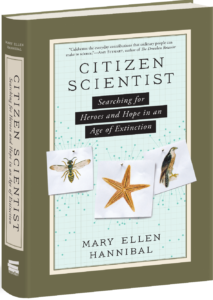 This guest blog comes from Mary Ellen Hannibal, author of Citizen Scientist.
This guest blog comes from Mary Ellen Hannibal, author of Citizen Scientist.
Mary Ellen Hannibal is an emerging voice in environmentalism and a sought-after speaker connecting the scientific community to the concerned public. Her writing has appeared in The New York Times, San Francisco Chronicle, Esquire, and Elle, among many others. She is an Alicia Patterson Foundation Fellow and a recipient of the National Society of Science Writers’ Science and Society Award.
In addition to the sixth mass extinction of plants and animals currently underway, we are also losing vast numbers of wildlife at the population level. Many of the species in question might not be officially on the brink of extinction, but their ecological functioning is being drastically curtailed. Since 1970 over all bird numbers have declined from 11.5 billion to 10 billion. There’s been a reduction in vertebrate numbers by almost 30 percent. Where, exactly, are we losing these plants and animals, how, and why? We can point to climate change as the culprit in reducing habitat for the polar bear, and outright hunting for decimating populations of African elephants. But more common species are shrinking too, from our own continent, states, counties, and backyards. PhD researchers including Stanford University’s Rodolfo Dirzo and colleagues have coined the term “defaunation” to describe what is happening to planet Earth and warn that such “animal declines will cascade onto ecosystem functioning and human well-being.” Species of plants and animals are the engines upon which the biotic world turns. Dirzo et al. comment that “defaunation remains a largely cryptic phenomenon. It can occur even in large protected habitats and yet, some animal species are able to persist in highly modified habitats, making it difficult to quantify without intense surveys.”
There are not enough scientists on Earth to design and implement the kinds of surveys that are necessary to keep track of how nature is doing. Technological tools, however, make it relatively easy for the public to partner with researchers to inventory and monitor vast areas. Citizen science makes it possible to study biodiversity across scales generally not accessible to individual scientists, and which global change necessitates today.
Consider a species like the monarch butterfly, the populations of which are in precipitous decline. Numbers counted up since 1993 show we are losing 38-44 million monarchs a year. The loss of this iconic creature has instigated a historic, cross-boundary commitment between the United States, Canada, and Mexico to join forces in recovering the monarch – making this arguably the biggest wildlife rescue mission ever undertaken. More than a dozen citizen science projects devoted to making monarch observations are today aggregated under the umbrella MonarchNet. The bug will not be restored without the help of citizen scientists, both in keeping tabs on them and in restoring their habitat so that their numbers can increase. “We enjoin a certain kind of community,” says Dr. Leslie Reis of Georgetown University, who co-runs MonarchNet. “These butterfly people go out, establish a transect, and monitor it. It’s very regional, and it takes management of volunteers.” By networking local and regional projects, Reis and colleagues make is possible to grapple with supporting the monarch’s migration, which occurs over several generations and across national boundaries.
Scott Loarie, co-director of the (free) citizen science platform iNaturalist, says that in order to get a handle on where we are losing species, when, and how, we need a “real-time sensor” of biodiversity. iNaturalist provides the tool by which this sensor is currently being assembled – a sensor comprised of citizen scientists. A photograph of a species of plant or animal using iNaturalist on a smart-phone is assigned the date, the time, the latitude, and the longitude of the observation, thus fixing that species occurrence in space and time. The observation is uploaded to a Facebook style feed under the scrutiny of users all over the world, who help identify the species designation. When there is expert consensus that yes, that spindly stalk is a Plantago erecta, the observation is uploaded into the Global Biodiversity Information Facility (GBIF), a database in use by scientists and natural resource managers all over the world. Information about where species are when, streaming live on iNaturalist, helps land managers identify the earliest instances of destructive invasive species, helps farmers stop disease and pest infestations before they decimate crops, and can help law enforcement intervene in illegal wildlife trafficking.
Today the iNaturalist community is steadily growing, with more than 300,000 users contributing more than 3.5 million high-quality biodiversity observations to our general knowledge and counting. There are hundreds of projects on iNaturalist, and you don’t need to join one to make observations of taxa from butterflies to frogs to mammals and birds. As more people use iNaturalist, and as those numbers of observations increase in frequency and density, we will be able to get a real time picture of biodiversity, something akin to a Fitbit taking the pulse of the natural world. From this data we will be able to discern the earliest signs of species extinctions so that local conservation efforts can be deployed to intervene.
iNaturalist is much more than an app, it is a global science instrument for conservation made up of its user community, people like you and me. Not only should we all march for our own science on Earth Day, it would be a good idea to take some iNaturalist observations along the way. Even in highly urbanized areas, there is wildlife – and the first step to saving it is seeing it.
Another huge dimension of citizen science is the community we are co-creating. Next May, join us in Minneapolis at the Citizen Science Association Conference. Whether or not you can come, check out the abstracts and presentations — a smorgasbord of great ideas and great projects. We are all scientists and this is our “peer review”!


